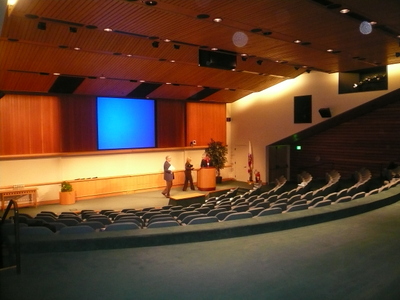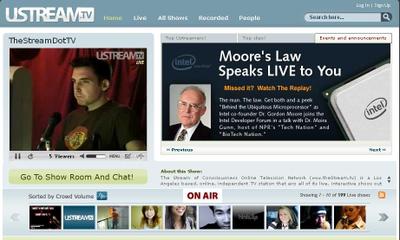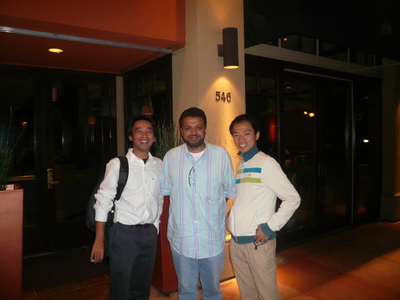Admob のCEO のOmar のインタビュー記事が掲載されています。写真を見るとフケているように見えるのですが、なんと30歳。3回目の起業という人間です。来週25日に会うことになっいて楽しみです。
 Interview with Omar Hamoui, CEO of AdMob
Interview with Omar Hamoui, CEO of AdMob
Less than 2 years ago, AdMob served its first mobile ad. The growth
since then has been phenomenal, and this month they should serve over
1.5 billion ads.
AdMob was founded by Omar Hamoui, who took a sabbatical from his MBA
studies to found the company. Read this interview with Omar to get his
view of the mobile advertising market, to hear the advice he gives
brands that want to start mobile advertising, and to understand why he
feels that AdMob can continue to outpace the competition.
Hi Omar. To start, can you tell us what’s your general view of the mobile advertising market these days?

First of all, the overall level of activity has picked up
substantially. Especially the M&A news over these past few days –
its very exciting times.
Secondly, the willingness of the big brands to participate in mobile
advertising has greatly increased. We’ve recently been running ads from
a long list of well known brands, including Starbucks, Covergirl, Coca-Cola, Disney, e-Bay, Paramount, etc. Six months ago I wouldn’t have been able to say that.
米国でも有力ブランドがモバイル広告に力をいれ始めたということでしょう。
What sort of ad targeting can AdMob offer to advertisers at the moment?
We actually offer pretty granular(粒度{りゅうど}の細かい) targeting. You can target by
factors such as country, mobile operator, type of handset, and
capability of handset. So for example we could run an ad that would
only go on Vodafone, in the UK, on Nokia handsets that support
polyphonic ringtones.
We can also target by content. In other words, an advertiser can
specify that their ads only go on, for example, sports sites, or music
sites.
Do you think you will someday be able to use additional targeting information from mobile operators?
We talk to a lot of mobile operators, but its not entirely clear
what they will do in terms of sharing their data. Most of them are
still trying to figure out how and if they can share the data – there
are a lot of privacy concerns.
AdMob has had incredible growth and success, what do you think are the reasons behind that success?
We were really the first to have a “self-serve” model, where an
advertiser or a publisher could come in and either add the code to
their site or create an ad on our site. That didn’t exist for mobile
before AdMob, and that allowed us to scale very rapidly.
And since then we’ve maintained focus on that ease-of-use, with the
underlying principle that mobile advertising should be as easy as
online advertising, in terms of creating an ad, reporting, changing the
ad, etc.
(以下のグラフのとおり、素晴らしい勢いで成長しています。特にFill rate が100%に近くなっていて広告主が多いことも示しています)

Is all of your business still using the “self-serve” model you mention?
Now we actually have a direct sales force that works with the big
brands I mentioned, building special campaigns for them and providing a
level of service that self-serve customers really aren’t going to need.
Especially for some of the higher quality inventory that is coming up,
and for banner ads. So we’re working on both sides of the equation.
AdMob recently introduced a special ad unit for the Apple iPhone. Can you tell us about that.
 We
started seeing a lot of iPhone traffic. We thought iPhone users would
simply be browsing the regular web, but as it turned out browsing was
not super optimal, so people went to mobile sites instead. Also, a lot
of companies started building iPhone specific applications – Facebook,
Digg, Yelp, all these guys. It became clear that content would be
consumed in a special way on the iPhone, so we built a special ad unit.
We
started seeing a lot of iPhone traffic. We thought iPhone users would
simply be browsing the regular web, but as it turned out browsing was
not super optimal, so people went to mobile sites instead. Also, a lot
of companies started building iPhone specific applications – Facebook,
Digg, Yelp, all these guys. It became clear that content would be
consumed in a special way on the iPhone, so we built a special ad unit.
It’s cool because it’s able to use html, be dynamic, link to the
Google maps application, do all kinds of neat stuff that you can’t do
outside of that environment.
AdMob has probably served more mobile ads than any other
company, ever. Based on your experience, is there any advice that you
would give a brand when they start to do mobile advertising?
I think the most important thing is to remember that you are going
to be advertising on a mobile phone, so make sure you have a landing
page or destination that will let the user do something interesting.
Don’t just use mobile to point them to your website!
We had campaigns where they’ve put together a short video in 3gpp
format that can be seen on a phone, that’s done very well. We’ve had
others that let you download backgrounds, or do a click to call – these
are phone specific and make a lot of sense.

I think people are well trained about what the ads should be and
what people will be interested in, that’s the easy part of the problem.
Its what do you do once they click that is harder.
As you mentioned earlier, the level of activity is really
heating up in mobile advertising. What do you think will keep AdMob
ahead as the competition heats up?
There’s nuances, and there’s major developments.
First, we’ve started to build a lot of interesting things around the
underlying tool. When you build a self-serve system, publishers and
advertisers have all sorts of things that they need. For example the
ability to filter out advertising that they don’t want, or limit
complete categories of ads, or for an advertiser to figure out which
publisher sites they will be on.
There are hundreds, if not thousands of these small things that you
learn by iterating over time. Because we are a little further down the
learning curve we have this stuff, but our competitors just aren’t
there.
Can you give an example of a major development that you believe will keep you ahead?
We are spending a huge amount of time on relevancy and optimization.
Because we have served so many ads, we have an enormous amount of data.
We have a team of PhD’s here combing through the data working on ad
serving, to be able to serve the best performing ad to any given user
at any given time.
(最適化や関連性の解析などに優秀な人間が数名配置されています。日本にも多くのアフィリエイトなどのアドネットワークがありますが、このポイントが一番大きな違いではないでしょうか)
We spoke earlier about targeting. There is actually a lot of
targeting that can be done without access to the subscriber information
the operator holds. We are able to observe behavior patterns in users
as they browse across the network, and we have a pretty good capability
in terms of being able to infer a lot more information about a user
based on what they do. We haven’t put this in place yet, but its one of
our near term plans.
This
takes a lot of data. We have over 2000 publisher sites and we’re
observing over 50 million page views of user behavior per day. This is
one place where our scale gives us an advantage.
Omar, thank you very much, and best wishes for continuing your success.




































 We
started seeing a lot of iPhone traffic. We thought iPhone users would
simply be browsing the regular web, but as it turned out browsing was
not super optimal, so people went to mobile sites instead. Also, a lot
of companies started building iPhone specific applications – Facebook,
Digg, Yelp, all these guys. It became clear that content would be
consumed in a special way on the iPhone, so we built a special ad unit.
We
started seeing a lot of iPhone traffic. We thought iPhone users would
simply be browsing the regular web, but as it turned out browsing was
not super optimal, so people went to mobile sites instead. Also, a lot
of companies started building iPhone specific applications – Facebook,
Digg, Yelp, all these guys. It became clear that content would be
consumed in a special way on the iPhone, so we built a special ad unit.


